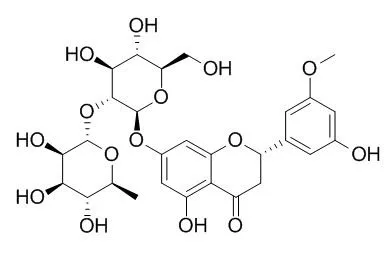| Description: |
Neohesperidin, a natural new nutrition sweetener, has antioxidant (IC50=22.31ug/mL), anti-inflammatory, and neuroprotective effects. It can attenuate cerebral ischemia-reperfusion injury via the inhibition of neuronal and oxidative stress through the regulation of the apoptotic pathway and activating the Akt/Nrf2/HO-1 pathway, it may be useful for the treatment and/or protection of gastritis. |
| Targets: |
Beta Amyloid | ROS | Calcium Channel | HO-1 | Nrf2 | Akt | Caspase | Bcl-2/Bax | TNF-α | COX |
| In vitro: |
| Curr Alzheimer Res. 2015;12(5):424-33. | | Inhibition of β-amyloid Aggregation By Albiflorin, Aloeemodin And Neohesperidin And Their Neuroprotective Effect On Primary Hippocampal Cells Against β-amyloid Induced Toxicity.[Pubmed: 25938872] | Being one of the hallmarks of Alzheimer's disease, β-amyloid (Aβ) aggregates induce complicated neurotoxicity. Evidences show that the underlying mechanism of neurotoxicity involves a glutamate receptor subtype, N-methyl-D-aspartate (NMDA) receptor, an increase in intracellular calcium(II) ion loading as well as an elevation in oxidation stress.
METHODS AND RESULTS:
In this work, among the 35 chemical components of Chinese herbal medicines (CHMs) being screened for inhibitors of Aβ aggregation, four of them, namely albiflorin, aloeemodin, Neohesperidin and physcion, were found for the first time to exhibit a potent inhibitory effect on Aβ(1-40) and Aβ(1-42) aggregation. Their neuroprotective capability on primary hippocampal neuronal cells was also investigated by MTT assay, ROS assay and intracellular calcium(II) ion concentration measurement.
CONCLUSIONS:
It was interesting to find that physcion was rather toxic to neuronal cells while albiflorin, aloeemodin and Neohesperidin reduced the toxicity and ROS induced by both monomeric and oligomeric Aβ species. In addition, albiflorin was particularly powerful in maintaining the intracellular Ca(2+) concentration. |
|
| In vivo: |
| J Asian Nat Prod Res. 2013 Sep;15(9):1023-37. | | Neohesperidin attenuates cerebral ischemia-reperfusion injury via inhibiting the apoptotic pathway and activating the Akt/Nrf2/HO-1 pathway.[Pubmed: 23952707] | Oxidative stress is well known to play a pivotal role in cerebral ischemia-reperfusion injury. On the basis of this fact, antioxidative agents have been demonstrated to be neuroprotective. Neohesperidin (NH) is abundant in citrus flavonoids and possesses reactive oxygen species scavenging activity and neuroprotective effects in vitro. However, little is known about its effects on cerebral ischemia-reperfusion injury and the underlying mechanisms.
METHODS AND RESULTS:
In this study, we use a rat model of middle cerebral artery occlusion (MCAO) to investigate the neuroprotective effects of NH. NH significantly improved neurological functions and attenuated MCAO-induced infarct volume, pathological changes, and neuronal loss. Moreover, it enhanced antioxidant capacity and suppressed oxidative stress in the brain. NH inhibited the MCAO-induced upregulation of Bax, cytochrome c, and cleaved caspase-9 and -3, as well as the downregulation of Bcl-2. Interestingly, NH treatment upregulated heme oxygenase-1 (HO-1) in a concentration-dependent manner, which was due to the NH-mediated activation of the protein kinase B (Akt)/nuclear factor erythroid 2-related factor 2 (Nrf2) pathway. NH also abolished the MCAO-induced inhibition of the Akt/Nrf2 pathway.
CONCLUSIONS:
In conclusion, NH attenuates cerebral ischemia-reperfusion injury via the inhibition of neuronal apoptosis and oxidative stress through the regulation of the apoptotic pathway and the Akt/Nrf2/HO-1 pathway. NH might be a promising preventive agent for ischemic stroke. | | Phytother Res. 2009 Dec;23(12):1748-53 | | Protective effects of neohesperidin and poncirin isolated from the fruits of Poncirus trifoliata on potential gastric disease.[Pubmed: 19367677] |
METHODS AND RESULTS:
The effects of Poncirus trifoliata (P. trifoliata) (Ponciri Fructus, PF) extract and its constituents such as Neohesperidin and poncirin on gastritis in rats and human gastric cancer cells were investigated. The PF 70% ethanol extracts (1 g) showed approximately 11.38% of acid-neutralizing capacities and cytotoxicity (IC50=85.39 microg/mL) against human AGS gastric cancer cells. In addition, Neohesperidin exhibited antioxidant activity (IC50=22.31 microg/mL) in the 1,1-diphenyl-2-picryldydrazyl (DPPH) radical-scavenging assay. Neohesperidin (50 mg/kg) and poncirin (100 mg/kg) significantly inhibited 55.0% and 60.0% of HCl/ethanol-induced gastric lesions, respectively, and increased the mucus content. In pylorus ligated rats, Neohesperidin (50 mg/kg) significantly decreased the volume of gastric secretion and gastric acid output, and increased the pH.
METHODS AND RESULTS:
From these results, it could be suggested that Neohesperidin and poncirin isolated from PF may be useful for the treatment and/or protection of gastritis. |
|






 Cell. 2018 Jan 11;172(1-2):249-261.e12. doi: 10.1016/j.cell.2017.12.019.IF=36.216(2019)
Cell. 2018 Jan 11;172(1-2):249-261.e12. doi: 10.1016/j.cell.2017.12.019.IF=36.216(2019) Cell Metab. 2020 Mar 3;31(3):534-548.e5. doi: 10.1016/j.cmet.2020.01.002.IF=22.415(2019)
Cell Metab. 2020 Mar 3;31(3):534-548.e5. doi: 10.1016/j.cmet.2020.01.002.IF=22.415(2019) Mol Cell. 2017 Nov 16;68(4):673-685.e6. doi: 10.1016/j.molcel.2017.10.022.IF=14.548(2019)
Mol Cell. 2017 Nov 16;68(4):673-685.e6. doi: 10.1016/j.molcel.2017.10.022.IF=14.548(2019)